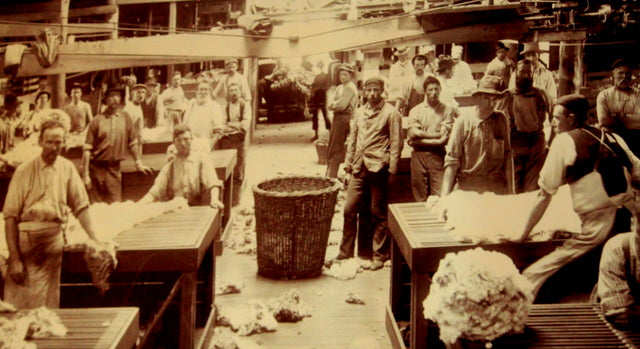Steve
On a recent trip through western NSW I passed by many famous stations whose history is best known through verse written by 'The Banjo',(A.B Paterson) about early shearing days. This gentleman certainly had a gift with words and portrayed our early pioneering days in a romantic and fanciful way, so much so infact the reality of hadships faced by the shearers, drovers and stockman, seemed barely to exist. Henry Lawson, another well known poet from the same era shaped his verse around the daily grind and described in detail the hardships and the heat, dust, droughts and loneliness these characters faced . The two gentleman lived lives in stark contrast to each other. The Banjo enjoyed many of the pleasures high society life had to offer where as Henry carried his sway and worked in the bush and in shearing sheds throughout outback Australia and often suffered from heavy bouts on the grog. Some rivalry existed between these two fellows and they exchanged friendly banter at each others work through the Bulletin magazine (known as the bushman's bible) much to the interest and pleasure of its readers. The reality is of course that Henry described life as it really was, and it was indeed a tough hard existence out there on the plains tramping the tracks carrying all their possessions to where the next work may or not be.
Shearers faced the toughest test of all workers in the bush, not only was life hard on the wallaby (track) but when they arrived at the next shed the really hard work began. If they didn't measure up there were always a camp of men at the station ready to take their place. Apart from harsh living conditions an average shearer will drag 160 or 9 tonnes of sheep almost 2 kilometres across the shed floor, restrain the animal with a bent back and push a hot heavy vibrating handpiece through heavy wool making around 5440 blows often in temperatures well over 40 degrees.The shearers also suffer injuries at six time that of other industries with most occurring to the back, arms legs and hands. To gauge the effort required to shear 200 sheep in eight hours it's the same amount of energy used by a cyclist riding in the Tour de France.
Big Burrawang (sometimes pronounced Burrawong) was one of Australias biggest sheds situated in NSW's central west at Yarrabandai. It stood 101 blade shearers and as you see in the photo above had a tram line down the board to carry wool shorn from the board to the wool room. At this stage the station was owned by Thomas Edols and his family still operate in the area but not on the same station. I have seen the remains of this shed where up to 250 men worked during shearing with the most being shorn around 1890 where 270,000 were put across the board. The station was just over half a million acres which incorporated free hold and lease hold country. The number of stands reduced to 88 when machines were introduced and even then the logistics in keeping sheep up to the shearers and away from the shed would have been a nightmare to say the least.
150 bales of wool, carrier T Baywater.
During 1884 Big Burrawang sent 5000 bales of wool off the station all of which were loaded on wagons and pulled to their destination by horse teams over rough tracks through the bush and could be held up for weeks by rain or flooded creeks or rivers. Pretty tough work which ever way you look at it living on the track for months at a time.
Blade shearer
The opening line of another verse by The Banjo is as follows, 'I've shorn at Burrabogie and I've shorn at Toganmain" I passed by both these stations during my recent trip and what's left of their woolsheds can be seen from the road close by the Murrumbidgee River.
Burrabogie Station
Burrabogie woolshed
Toganmain Station.
Shearing the Rams, by Tom Roberts
The famous painting by Tom Roberts, Shearing The Rams reminds me of one of the first jobs I took on after leaving school. It was at a merino stud and the stud rams were being shorn by blade shearers rather than machines which leaves a better tip on the wool and enhances the wools appearance later in the year when the rams go to sale. I had the job as presser. The blade shearers were two brothers and their two sons and even though it was a family show there was still that fierce competition between them as to who had the highest tally. Being one or two up at the end of a run or at cut-out for that matter is important to all shearers and they bend their backs and trim their blows to get the upper hand. You generally find in a shed that the 'Gun' or 'Ringer' of the shed will have a shearer beside him or close by who will as the saying goes,'will blow wind up his arse' to keep the bastard honest and make him work hard for his tally. It was amazing working in a shed for blade shearers, it's so quiet, generally the diesel engine is throbbing away and as the shearers pull the cord to start their next sheep the noise of the cutter running over the comb can be heard. The dogs make plenty of noise as the penner brings up more sheep and the odd call for 'wool away' as a shearer finishes his sheep letting the rousey know to get down the board smartly to pick up the last fleece.
Tubbo woolshed.
Shearers quarters, Tubbo Station.
Tubbo Station above was established in 1850 by the Scottish emigrant, John Peter. At that point in time the station covered 200,000 acres and as well, the owner had additional leeses amounting to 540,000 acres in total. During the late 1800's Tubbo shore 121,800 sheep annually. Driving passed these historic stations today the country close by the Murrumbidgee River and the old woolsheds has changed dramatically. No longer is this area reserved for holding paddocks, ram and horse paddocks but is now set out for irrigation. The crops this year look fantastic and should yield far higher than average due to the higher rainfall that occurred this year. Hopefully the rain will stop long enough to get the crop off. Until next time. Steve and Sass.














